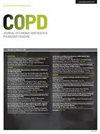High Blood Eosinophil Count at Stable State is Not Associated with Airway Microbiota Distinct Profile in COPD
IF 3.1
3区 医学
Q1 Medicine
International Journal of Chronic Obstructive Pulmonary Disease
Pub Date : 2024-03-18
DOI:10.2147/copd.s453526
引用次数: 0
Abstract
Purpose: The heterogeneity of clinical features in COPD at stable state has been associated with airway microbiota. Blood eosinophil count (BEC) represents a biomarker for a pejorative evolution of COPD, including exacerbations and accelerated FEV1 decline. We aimed to analyse the associations between BEC and airway microbiota in COPD at stable state.Patients and Methods: Adult COPD patients at stable state (RINNOPARI cohort) were included and characterised for clinical, functional, biological and morphological features. BEC at inclusion defined 2 groups of patients with low BEC < 300/mm3 and high BEC ≥ 300/mm3. Sputa were collected and an extended microbiological culture was performed for the identification of viable airway microbiota.
Results: Fifty-nine subjects were included. When compared with the low BEC (n=40, 67.8%), the high BEC group (n=19, 32.2%) had more frequent exacerbations (p< 0.001) and more pronounced cough and sputum (p< 0.05). The global composition, the number of bacteria per sample and the α-diversity of the microbiota did not differ between groups, as well as the predominant phyla (Firmicutes), or the gender repartition.
Conclusion: In our study, high BEC in COPD at stable state was associated with a clinical phenotype including frequent exacerbation, but no distinct profile of viable airway microbiota compared with low BEC.
Keywords: COPD, eosinophil, sputum, microbiota
稳定状态下的高血嗜酸性粒细胞数与慢性阻塞性肺疾病气道微生物群特征无关
目的:慢性阻塞性肺病稳定期临床特征的异质性与气道微生物群有关。血液嗜酸性粒细胞计数(BEC)是慢性阻塞性肺病恶化的生物标志物,包括病情加重和 FEV1 加速下降。我们的目的是分析处于稳定状态的慢性阻塞性肺病患者的血液嗜酸性粒细胞计数与气道微生物群之间的关系:纳入处于稳定状态的成年 COPD 患者(RINNOPARI 队列),并对其临床、功能、生物学和形态学特征进行分析。纳入时的BEC分为低BEC < 300/mm3和高BEC ≥ 300/mm3两组。收集痰液并进行扩展微生物培养,以鉴定气道微生物群:结果:共纳入 59 名受试者。与低 BEC 组(40 人,67.8%)相比,高 BEC 组(19 人,32.2%)的病情加重更频繁(p< 0.001),咳嗽和咳痰更明显(p< 0.05)。各组间微生物群的总体组成、每份样本的细菌数量和α-多样性没有差异,主要菌门(真菌)和性别比例也没有差异:结论:在我们的研究中,慢性阻塞性肺病稳定状态下的高BEC与包括频繁恶化在内的临床表型有关,但与低BEC相比,气道微生物群没有明显的特征:慢性阻塞性肺病 嗜酸性粒细胞 痰 微生物群
本文章由计算机程序翻译,如有差异,请以英文原文为准。
求助全文
约1分钟内获得全文
求助全文
来源期刊

International Journal of Chronic Obstructive Pulmonary Disease
RESPIRATORY SYSTEM-
CiteScore
5.10
自引率
10.70%
发文量
372
审稿时长
16 weeks
期刊介绍:
An international, peer-reviewed journal of therapeutics and pharmacology focusing on concise rapid reporting of clinical studies and reviews in COPD. Special focus will be given to the pathophysiological processes underlying the disease, intervention programs, patient focused education, and self management protocols. This journal is directed at specialists and healthcare professionals
 求助内容:
求助内容: 应助结果提醒方式:
应助结果提醒方式:


